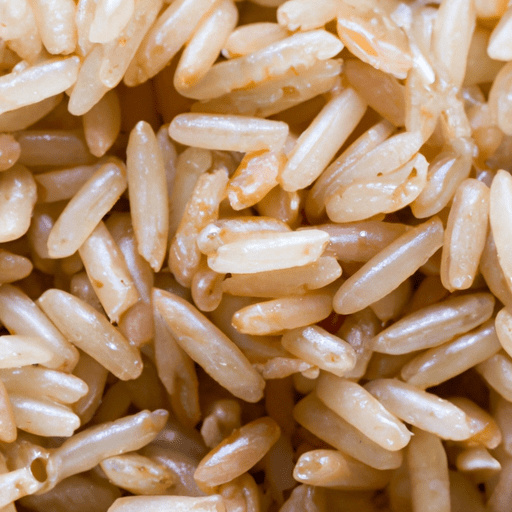The Wonders of Cooked Brown Rice
When it comes to healthy and versatile grains, cooked brown rice undoubtedly takes the spotlight. Bursting with incredible flavor and boasting a multitude of culinary applications, this humble grain has earned its place as a mainstay in kitchens around the world. In this blog post, we’ll take a deep dive into the world of cooked brown rice, exploring its taste, common uses in cooking, nutritional value, and uncovering some interesting history and facts along the way.
The Taste of Nutritional Goodness
Cooked brown rice has a delightful nutty flavor and a slightly chewy texture that makes it a lovely addition to a wide variety of dishes. Its earthy taste pairs excellently with both robust and delicate flavors, allowing it to harmonize with diverse ingredients. Whether it’s served as a base for stir-fries, incorporated into sushi rolls, or used as a stuffing for vegetables, cooked brown rice adds a distinct depth to every dish.
The Culinary Chameleon
One of the reasons cooked brown rice is beloved by chefs and home cooks alike is its versatility. This grain adapts wonderfully to different cooking techniques and can be used in a myriad of dishes. It is fantastic in pilafs, grain bowls, and salads, where it can absorb the flavors of dressings and dress up a simple meal. You can also use cooked brown rice to create delicious rice puddings, casseroles, and even veggie burgers. The possibilities are truly endless!
Nutritional Powerhouse
Beyond its incredible taste and culinary flexibility, cooked brown rice is also a nutritional powerhouse. Unlike refined white rice, brown rice retains its bran and germ layers, making it a whole grain that is packed with essential nutrients. It is an excellent source of fiber, which aids digestion and promotes a healthy gut. Additionally, cooked brown rice contains valuable minerals such as magnesium, selenium, and manganese, as well as B vitamins.
A Brief History and Fascinating Facts
Rice has been cultivated and enjoyed for centuries, with its origins dating back to ancient China. Historical records trace the consumption of rice to as early as 2,800 BC. Brown rice, in particular, has a rich history. Before modern milling techniques were developed, all rice was brown. It was not until the mid-19th century that the process of polishing rice to remove the outer bran layers became popularized.
Interestingly, brown rice became more widely consumed and appreciated during the 20th century as the health benefits of whole grains gained recognition. Today, it continues to be a staple in many cultures and cuisines worldwide.
Conclusion
From its enticing taste and culinary adaptability to its impressive nutritional profile, cooked brown rice is truly a superstar in the grain family. Its nutty flavor adds depth to countless dishes, while its versatility allows it to shine in a variety of preparations. Whether you’re looking for a healthy side dish, a hearty main course, or even a sweet dessert, cooked brown rice is an excellent choice.
So why not elevate your meals and embrace the wonders of cooked brown rice? Your taste buds and your body will thank you!
Origin and Culinary History:
- Brown rice is believed to have originated in Asia, particularly in Southeast Asia and the Indian subcontinent, where it has been cultivated for thousands of years.
- It is considered to be the “whole grain” form of rice because it retains the outer bran layer, germ, and endosperm, unlike white rice which has had the bran and germ removed.
- Throughout history, brown rice was a staple food for many civilizations, particularly in Asia, due to its abundance and nutritional value.
Common Uses:
- Cooked brown rice is a versatile ingredient and forms the basis for many dishes around the world.
- It can be used as a side dish, served with curries, stews, stir-fries, or used as a base for grain bowls.
- Brown rice can also be used in salads, soups, casseroles, sushi, and even desserts.
Nutritional Benefits:
- Brown rice is a great source of complex carbohydrates, providing a steady release of energy.
- It is relatively low in fat and contains no cholesterol.
- Cooked brown rice is a good source of dietary fiber, which aids digestion and helps maintain a healthy digestive system.
- It contains essential minerals such as manganese, magnesium, and phosphorus.
- Brown rice also contains B vitamins, including niacin and thiamine.
Unique Properties and Significance:
- Brown rice has a nutty flavor and a chewy texture due to the presence of the bran layer.
- Its high fiber content provides a feeling of fullness and can help with weight management.
- Brown rice has a lower glycemic index compared to white rice, meaning it causes a slower rise in blood sugar levels.
- Due to its nutritional value and benefits, brown rice has gained popularity as a healthier alternative to white rice in many Western countries.
Remember to always cook brown rice properly, as undercooked brown rice may be hard and chewy, while overcooked rice can become mushy.




Use the share button below if you liked it.
It makes me smile, when I see it.